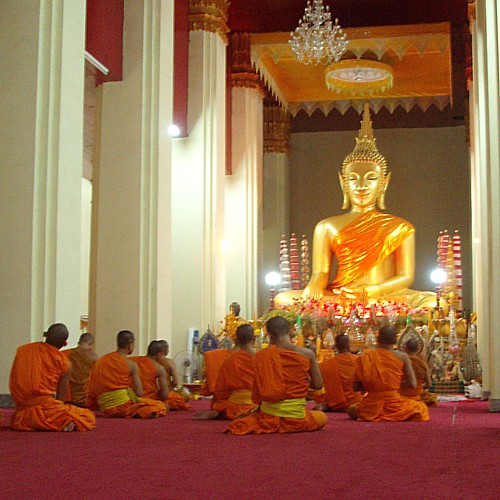Theravada temples in Thailand & Laos, as well as Thai (not sure about the Sri Lankan & Burmese) Theravada temples in Singapore usually start off with the same passages:
- Title (youtube video link / text link)
- Ratanattaya vandana (0:00-2:15 / #5)
- Namo tassa... (2:34-3:03 / #2)
- Buddha nussati (3:04-3:44 / #13)
- Buddha bhigiti (3:45-6:04 / #14)
- Dhamma nussati (6:13-6:37 / #15)
- Dhamma bhigiti (6:47-8:55 / #16)
- Sangha nussati (0:00-1:10 / #17)
- Sangha bhigiti (1:21-3:22 / #18)
In addition to those listed above, other passages may be chanted too. Choice of these additional passages may differ from temple to temple, & from day to day within the same temple. In the second video linked above, 'reflections on sharing blessings' (3:32-5:36 / last section of this site) & the 'five subjects for frequent recollection' (5:47-7:19 / text) are chanted at the end. Some temples that the cat has been to include a short period of sitting meditation in between.
Some temples in Singapore & Bangkok have several copies of chanting books lying around the sim for any interested lay people to pick up & follow/join in the chanting. In the Mahayana tradition (dominant in Singapore), chanting is something that lay people participate in together with monks & nuns, & there are 'mass chanting/recitation' events held as part of celebrations for festivals such as Vesak. In Malaysia, Taiwan & Singapore, it is not unusual for people to listen to CDs of musical versions of the more well-known Mahayana chants e.g. 大悲咒 da4 bei1 zhou4 (Great compassion mantra) & 心经 xin1 jing1 (Heart sutra), & even display the mantra 南无阿弥陀佛 Namo Amitabha on the rear windshield of vehicles.
While monks at the Sri Lankan Theravada temple in Singapore also lead lay people in chanting from texts on Buddhist 'holy' days, in Thailand & Laos (where Theravada dominates) chanting seems to be more of something that lay people invite monks to do on their behalf. Perhaps that is why in Laos, the only chanting books the cat has seen all belonged to novice monks, & to date the only local lay people it has seen at evening chanting were two consultants (one a former monk), when a third consultant invited the 3 of us to listen to him lead the chanting in his temple in 2009.
Evening chanting in Wat Chan, Vientiane (photo from 2007 trip):

Full monks at the front, novices behind them, & laymen & cats at the back with full view of what certain 'more monk-ey than monk' novices do behind the backs of the monks - texting/chatting on mobile phones, throwing chanting books at/poking/hitting their friends, trying to push one another over, etc...boys will be boys ;)
Depending on the temple, attendance may (not always) be compulsory. Some older monks may chose to chant at the altar in their own living quarters, especially if they have mobility problems. The cat has also sat through 'roll calls' at the end of evening chanting sessions where attendance is checked. In a consultant's Vientiane temple, everyone will be given extra chores to do should anyone be absent more than thrice during phansa (rains retreat). On the other hand, the cat has also been to a large Thai temple during phansa where only a few of the oldest (except the wheelchair-bound abbot) monks & zero novices turned up...
On its last evening in Luang Prabang, the cat finally figured out why temple chanting in Laos sounds different from what it is used to hearing elsewhere - the majority of the voices are the higher pitched ones of young novices, as compared to the deeper ones of older monks in Singapore & Thailand. At this particular temple, chanting was 'fast-forwarded', led by Monk B at breakneck speed - the fastest the cat has ever heard anywhere. All 'triple bows' were similarly accelerated (!!) & everything was over in 30 minutes flat, while the monks & novices in Wat Next Door continued to drone on long after the sun had set. Things have since slowed down after Monk B left in 2008, & Monk A & Monk B's younger brother now lead at a less breathless pace :P
- Mahayana, Theravada, Vajrayana
- 淨土宗 Jingtuzong aka. Pureland, 禅 Zen aka. Chan, Tibetan, etc
- มหานิกาย Maha-nikaya, ธรรมยุตนิกาย Dhammayut-nikaya, etc
- e.g. Japanese [ho] or Chinese [fa] pronounciation of the Chinese translation of Sanskrit [dharma], Sinhala or Khmer or Burmese translations of Pali, etc


No comments:
Post a Comment